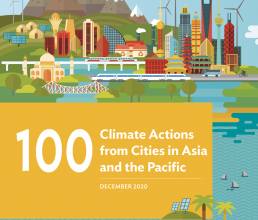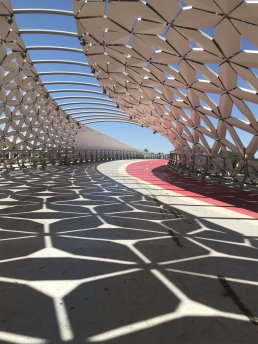First appeared in

Asian Development Bank
100 Climate Actions from Cities in Asia and the Pacific
In July 2018, a new pedestrian bridge, "Atyrau Kopiri", was opened in Kazakhstan's capital, Nur-Sultan, promoting sustainable urban mobility. It enables walking, cycling, socializing and connects to the right bank of the Yesil river.
In July 2018, a new pedestrian bridge, "Atyrau Kopiri", was opened in Kazakhstan's capital, Nur-Sultan, promoting sustainable urban mobility. It enables walking, cycling, socializing and connects to the right bank of the Yesil river.
The 313 meter-long Atyrau Kopiri pedestrian bridge connects the river banks of Nur-Sultan, Kazakhstan’s capital formerly called Astana, and promotes zero-emission transportation modes.
30
MINUTE REDUCTION IN TIME TO ACCESS CERTAIN AREAS
The bridge’s design takes inspiration from natural forms and when viewed from above, it resembles the shape of a fish, the symbol of Kazakhstan’s Atyrau region on the East of the country that borders the Caspian Sea.
The bridge, connected to 56 kilometers of additional urban bike lanes, aims to decrease traffic jams and promote green transportation such as walking and cycling. The bridge also reduces the time to access the left side of the river during rush hour by 30 minutes. Moreover, Nur-Sultan’s citizens and tourists can now utilize the public space in the middle of the bridge, by listening to small-scale concerts during the summertime for example, or for jogging in a nearby park.

The 313 meter-long Atyrau Kopiri pedestrian bridge connects the two banks of the river in Nur-Sultan, providing walking and cycling routes as well as recreational opportunities (photo by Na Won Kim).
The Challenge
Nur-Sultan suffers from a combination of high levels of congestion and poor air quality. The city is partly addressing these challenges with investment in public transport and low-carbon alternatives.
Co-Benefits
Social The bridge offers communal and recreational areas for citizens, and reduces commuting time to access the left side of the river, especially during rush hour.
Health The city hopes that by encouraging walking and cycling, residents will use their cars less often, leading to improved air quality in the city.

